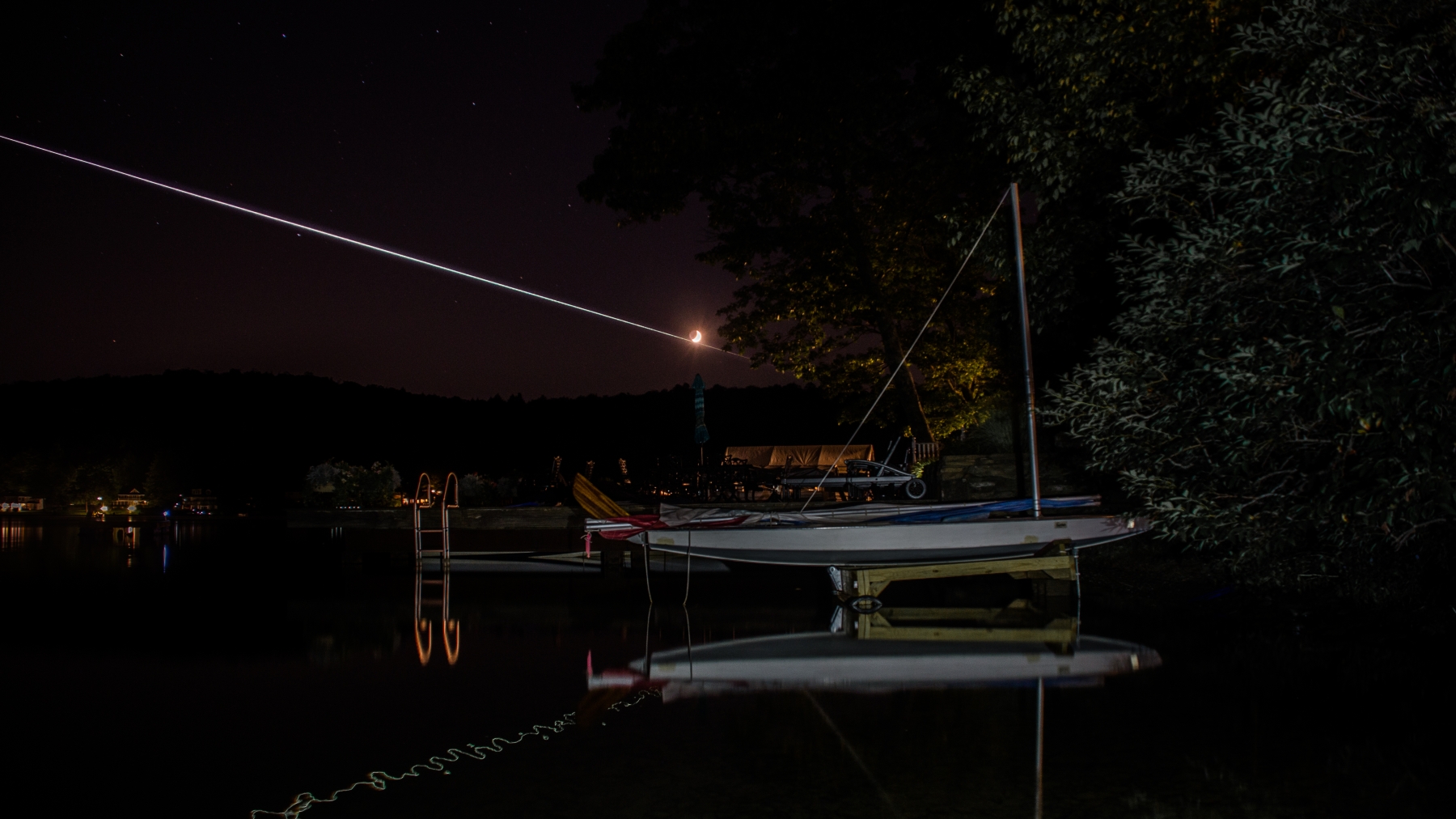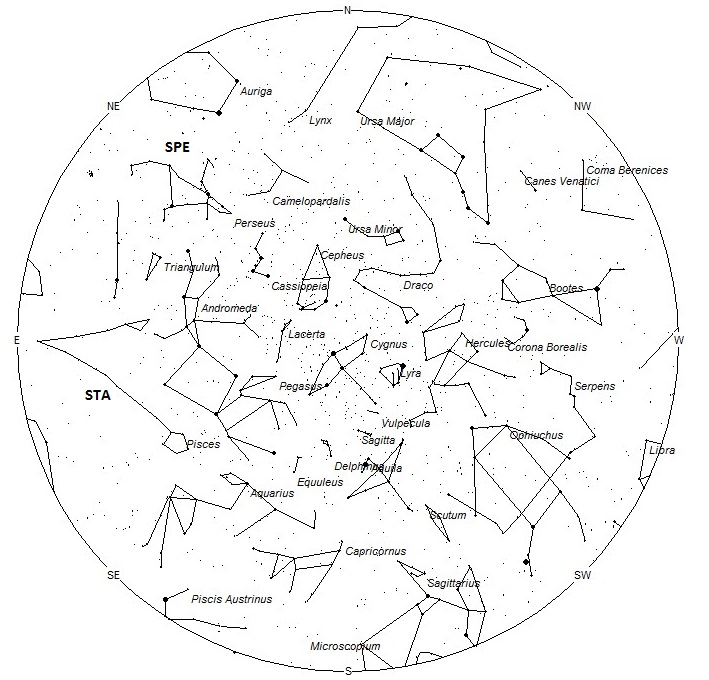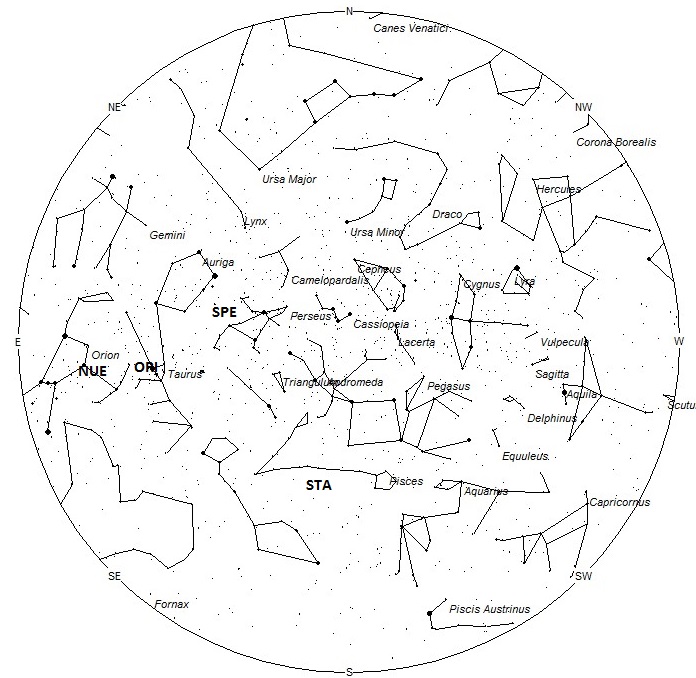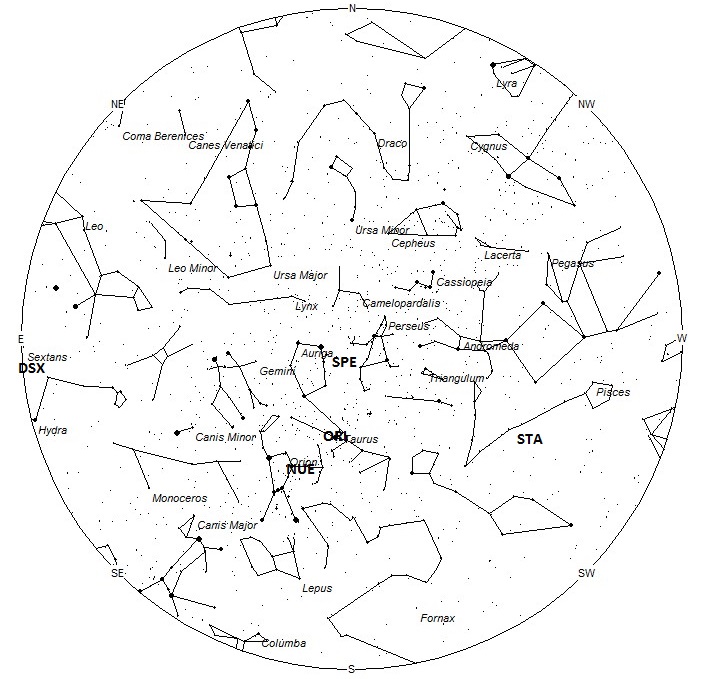
During this period the moon will reach its first quarter phase on Wednesday September 27th. At this time the moon will be located 90 degrees east of the sun and will set near 0100 local summer time (LST). This weekend the waxing crescent moon will set shortly after dusk, allowing meteor observers dark skies the remainder of the night. The estimated total hourly meteor rates for evening observers this week is near 4 for those viewing from the northern hemisphere and 3 for those located south of the equator. For morning observers the estimated total hourly rates should be near 16 as seen from mid-northern latitudes and 12 from the southern tropics. The actual rates will also depend on factors such as personal light and motion perception, local weather conditions, alertness and experience in watching meteor activity. Note that the hourly rates listed below are estimates as viewed from dark sky sites away from urban light sources. Observers viewing from urban areas will see less activity as only the brighter meteors will be visible from such locations.
The radiant (the area of the sky where meteors appear to shoot from) positions and rates listed below are exact for Saturday night/Sunday morning September 23/24. These positions do not change greatly day to day so the listed coordinates may be used during this entire period. Most star atlases (available at science stores and planetariums) will provide maps with grid lines of the celestial coordinates so that you may find out exactly where these positions are located in the sky. A planisphere or computer planetarium program is also useful in showing the sky at any time of night on any date of the year. Activity from each radiant is best seen when it is positioned highest in the sky, either due north or south along the meridian, depending on your latitude. It must be remembered that meteor activity is rarely seen at the radiant position. Rather they shoot outwards from the radiant so it is best to center your field of view so that the radiant lies at the edge and not the center. Viewing there will allow you to easily trace the path of each meteor back to the radiant (if it is a shower member) or in another direction if it is a sporadic. Meteor activity is not seen from radiants that are located far below the horizon. The positions below are listed in a west to east manner in order of right ascension (celestial longitude). The positions listed first are located further west therefore are accessible earlier in the night while those listed further down the list rise later in the night.
These sources of meteoric activity are expected to be active this week.
.
We are now encountering inbound debris from comet 2P/Encke, which has a radiant superimposed upon the anthelion radiant. Since it has been shown that meteors from 2P/Encke are more numerous we will recognize this activity as the Southern Taurids (STA) until November 19th, when it will switch to the northern branch. The activity profile for the Southern Taurids is unusual in that there are several peaks and valleys throughout the activity period. The difference between the peaks and valleys is not great, but definitely noticeable in video data. These peaks occur near October 10, October 29 through November 3, and near November 15th. After this last peak activity quickly disappears but the northern branch continues into December. The center of the large radiant is currently located near 00:52 (013) +04. This position lies in southern Pisces, 3 degrees south of the fourth magnitude star known as Delta Piscium. These meteors may be seen all night long but the radiant is best placed near 0200 LST when it lies on the meridian and is located highest in the sky. Rates at this time should be near 2 per hour regardless of your location. With an entry velocity of 27 km/sec., the average Southern Taurid meteor would be of slow velocity.
The September Epsilon Perseids (SPE) are active from September 3 through October 3 with the peak occurring on the night of September 9/10. The radiant is currently located at 04:16 (064) +41. This position lies in eastern Perseus, 3 degrees northeast of the 3rd magnitude star known as epsilon Persei. The radiant is best placed near 0500 LST, when it lies highest above the horizon. Rates are expected to be near 1 per hour as seen from the northern hemisphere and less than 1 as seen from the southern hemisphere. With an entry velocity of 65 km/sec., most activity from this radiant would be swift.
You may be surprised to see the Orionids (ORI) as an active radiant this time of year, but there is clear evidence from the IMO video database that this shower is active long before its October 22nd maximum. In fact it is in the top four most active radiants throughout September. This radiant is currently located at 04:28 (067) +17, which places it in central Taurus, very close to the spot occupied by the 1st magnitude orange star known as Aldebaran (alpha Tauri). This area of the sky is best placed in the sky during the last hour before dawn, when it lies highest above the horizon in a dark sky. Current rates would be near 2 per hour no matter your location. With an entry velocity of 67 km/sec., most activity from this radiant would be of swift speed.
The nu Eridanids (NUE) were co-discovered by Japanese observers using SonotoCo and Juergen Rendtel and Sirko Molau of the IMO. Activity from this long-period stream stretches from August 24 all the way to November 16. A very shallow maximum occurred near September 8. The radiant currently lies at 05:08 (077) +06, which places it in western Orion, 3 degrees west of the 2nd magnitude star known as Bellatrix (gamma Orionis). This area of the sky is best seen during the last dark hour before dawn when the radiant lies highest in a dark sky. Current rates are expected to be near 1 per hour during this period no matter your location. With an entry velocity of 67 km/sec., the average meteor from this source would be of swift velocity. Some experts feel that these meteors are early members of the Orionid shower, which peaks on October 22.
The Daytime Sextantids (DSX) are not well known due to the fact that the radiant lies close to the sun and these meteors are only visible during the last couple of hours before dawn. The radiant is currently located at 10:00 (150) +00. This position lies in western Sextans, 2 degrees west of the 4th magnitude star known as alpha Sextantis. This area of the sky is best placed in the sky during the last hour before dawn, when it lies highest above the horizon in a dark sky. Current rates would be most likely less than 1 per hour no matter your location. Spotting any of this activity would be a notable accomplishment. With an entry velocity of 33km/sec., most activity from this radiant would be of medium-slow speed.
As seen from the mid-northern hemisphere (45N) one would expect to see approximately 10 sporadic meteors per hour during the last hour before dawn as seen from rural observing sites. Evening rates would be near 3 per hour. As seen from the tropical southern latitudes (25S), morning rates would be near 7 per hour as seen from rural observing sites and 2 per hour during the evening hours. Locations between these two extremes would see activity between the listed figures.
The list below offers the information from above in tabular form. Rates and positions are exact for Saturday night/Sunday morning except where noted in the shower descriptions.
| SHOWER | DATE OF MAXIMUM ACTIVITY | CELESTIAL POSITION | ENTRY VELOCITY | CULMINATION | HOURLY RATE | CLASS |
| RA (RA in Deg.) DEC | Km/Sec | Local Summer Time | North-South | |||
| Southern Taurids (STA) | Oct 29-Nov 03 | 00:52 (013) +04 | 27 | 02:00 | 2 – 2 | II |
| September Epsilon Perseids (SPE) | Sep 10 | 04:16 (064) +41 | 65 | 05:00 | 1 – <1 | II |
| Orionids (ORI) | Oct 22 | 04:28 (067) +17 | 67 | 05:00 | 2 – 2 | I |
| nu Eridanids (NUE) | Sep 08 | 05:08 (077) +06 | 67 | 06:00 | 1 – 1 | IV |
| Daytime Sextantids (DSX) | Sep 29 | 10:00 (150) +00 | 33 | 11:00 | <1 – <1 | IV |
 American Meteor Society
American Meteor Society



Hi question for you do you think that we will have a big meteor strike us here on earth on September 23rd 2017
everyone thinks this is the end ……what do you think ??
Cariekay and All,
There are objects out in space that could strike the earth at any time. Fortunately none of them are large enough to cause any catastrophic effects upon the earth. We are aware of objects down to 7 feet across that may approach the earth and none of these objects will pass within 2000 miles in the near future.
Robert Lunsford
i had seen what looked like to be a meteor crashing down on my way to work at approximately 12:25 am. It wasn’t at an angle. It seems to be dropping straight down and at my distance it looked to be about the size of a basketball engulfed in fire. I was located at the time near New Castle, Colorado. I was wondering where it may have hit.
Stacy and All,
So far we only have 2 other reports of this fireball. This is far too few to calculate a accurate flight path and possible landing area. We need at least 100 to accurately determine these parameters.
Robert Lunsford
I also witnessed a fireball that night! Look at my reply to the original post. Does this sound familiar to the other reports??Thanks!
I also witnessed a very bright green fireball that was VERY slow moving. In fact, it caught my eye, I looked away for a second until it occurred to me that it was possibly a meteor, looked back and witnessed it break up into three orange pieces that shot off in different direction. It was bright enough, and slow enough to give me the chance to point at it and yell at my friend to look…
There was a very visible one over south Bend Indiana about 8:30 pm! First one I have ever seen! At first I thought it was a low shooting star but it turned red and looked like it blew up and disappeared. Very excited to have seen one for the first time in my life!!
saw a meteor skimming S-SW at approx. 2250hrs, seen from Western Arizona, Los Angeles to San Diego area should had no problem seeing it as well. Brilliant top and bottom arched streams, “rooster tails” as item was entering atmosphere.
Jase and All,
Actually this was no meteor. It was a rocket launch from Vandenberg Air Force Base near Lompoc, California. To read more about this launch visit: http://www.vandenberg.af.mil/News/Article-Display/Article/1322402/atlas-launch-successful/
Robert Lunsford
Yep, saw that too!
I saw a possible meteor is the south east sky at about 11:00 PM PST in Southern California. Any idea what it was?
Please my reply to Jase Leon…
Robert Lunsford
Hi, yesterday (sept 23) i observed a meteor (i believe, in the west coast L.A. area) that had a half moon shine on it. If any of you know what kind of phenomenon is that? or if is a special kind of thing? Thank you :3
Dear Ciara and All,
What you saw was not a meteor or a fireball. It was a rocket launch from Vandenberg Air Force Base. See: http://www.vandenberg.af.mil/News/Article-Display/Article/1322402/atlas-launch-successful/
Robert Lunsford
Saw one that lasted 20 to 30 seconds last night over the Pacific Ocean September 23rd 2017 from San Diego never seen one last so long was in disbelief
See my reply to Ciara…
September 25, 2017 … Suffolk, VA … I saw a beautiful meteor last night about 2:30 a.m. … It kind of streaked and then looped upwards and away from me! Really nice display! So glad I decided to look out my window when I got up!
Hey neighbor! I also saw a beautiful and bright fireball around the same time.
-southern Chesapeake
I saw a very weird object in the sky on September 23rd at ~4am. it appeared to be from a single point around the M36 star cluster in Auriga, it seems to somewhat line up with the PSE according to your star chart. It only lasted a few seconds but it was far brighter than venus, probably as bright as the moon. My wife saw it at the same time. There didn’t appear to be any motion associated with it, just a very intense flare.
I’ve never seen anything like it before. Talking with Mat Kaplan from the planetary society (www.planetary.org) he suggested it might be an iridium flare but based on the research I’ve done it doesn’t seem to fit, the other idea was a meteor that was headed directly at us.
If you have any ideas i’d appreciate hearing back!
Justin and All,
I would agree with Mat that this was a satellite flare. Not all of them are caused by Iridium satellites. There are some that flare brightly unexpectedly. I have seen this happen with the Hubble Space Telescope. I hope this helps!
Robert Lunsford
Justin, I used to have an app on my phone which would let me know when an iridium flare would be viewable in my area~ consequently, I have witnessed a great many of them and what you have described fits exactly with how they appear. Also, it doesn’t necessarily have to have been from that particular kind of satellite since there are so many different types of satellites which orbit
??? Help ???
http://www.dm.be/s/ax6bbef81/15c2df
Tris and All,
This asteroid already passed by the Earth on Friday September 1st. We seemed to have survived that encounter…
I’m sitting on my porch, literally ten minutes ago. I look to sky above my home/Head, only to see the most beautiful bright glistening Blueish , Orange, purple and the brightest white tail chasing its fire-ball-ish head of a meteor (I’d imagine) which started to appear as a star-shooting across the sky and suddenly it must have just entered the atmosphere at this very moment. When I say beautiful, it was like out of a children’s story book. I’d never seen such beauty above head. I’m still in absolute Awe if it’s very raw beauty and even its happening. I love sky watching and this feels like I’ll bever see this again – almost like a sign from the guy in the sky. Awesome. Thought I’d share.
Looked just like this toward the end…
https://encrypted-tbn0.gstatic.com/images?q=tbn:ANd9GcRWmo1v0bqp3oXNZYPAi4VF8QzEJiZS_-p6xleLU1dwdHfzPOb4
it was part of Leonid’s starfall. The annual autumn Leonid meteor shower is considered not the most intense, but the fastest. Usually the average intensity of the stargazing does not exceed 10-15 meteors, but in 2017, as astronomers promise, the flow strength will be up to 20 meteors per hour. I wrote about this in my report at https://coolessay.net/write-my-report